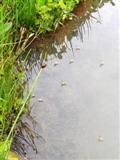Fishing a PMD Hatch
On many rivers, Pale Morning Duns (PMDs) are a relief to both anglers and fish alike. In the West, the hatch of the medium-sized mayfly can occur both in numbers and duration during the summer months. After a winter and spring of fishing miniscule midge patterns or trying to time sporadic drake emergences, PMDs can ease anglers and fish into a fairly consistent daily schedule of hatch and spinner fall. This allows an angler to spend time not only on honing patterns for each stage of the Pale Morning Dun's lifecycle, but also on focusing on specific water types to fish certain patterns.
PMD Lifecycle
PMD nymphs inhabit riffles, runs, and flats of rivers. As they mature, nymphs develop dark wing pads. Despite being feeble swimmers, they are generally not available to trout until a few hours before their emergence. Once ready to hatch, the nymphs slowly rise to the water’s surface, buoyed by internal gases and their wriggling swimming motion. The water’s meniscus traps the mayfly nymphs temporarily. Their thorax then splits, allowing the duns to climb through the hole to perch atop the rubbery water surface while their wings dry for flight. Weather conditions and wind affect how long the PMD duns ride the surface before flying to streamside vegetation. The duns normally molt into true mayfly adults, or spinners, within 24 hours. Once they molt, male Pale Morning Dun spinners form mating swarms over riffles to attract female partners. This usually occurs during windless periods in either the morning or evening. Mating occurs in-flight, and once completed the male PMD adults fall spent to the water’s surface while the females lay their eggs by dipping their abdomen into the water’s surface.
Daily PMD Hatch Schedule
To maximize the angler’s results when fishing a Pale Morning Dun hatch, he or she must know the general time periods during the day that the hatch occurs. The PMD hatch can be quite regular, and trout will quickly pick up the daily schedule of when the hatch and its associated stages occur. The nymphs become restless a few hours before emergence and subsequently become increasingly available to trout in the drift. It is at this time that an impressionist nymph fished deep will start taking fish. An appropriately-sized Bead Head Pheasant Tail works well during this time.
As the mayfly hatch builds up steam, a substantial number of nymphs will be in the middle of the water column at any given time. A prime location to fish during this period is shallow- to medium-depth riffles. Often, fish will become quite active and can be spotted moving vertically and laterally to intercept drifting nymphs. A very effective fly at this time is Mike Mercer’s PMD Trigger Nymph. The fly features a ball of sparkly yellow dubbing on top its thorax to imitate a PMD nymph that has started its emergence sub-surface. As the hatch progresses, trout will begin to focus in on this aspect; it is a highly effective triggering characteristic.
Once the hatch is underway and an abundant number of duns are riding the surface, trout will shift their focus to include taking duns off the surface. Several important factors determine how selective trout become with respect to feeding on mayfly adults. If it is a windy day the PMD duns will skate across the surface, leaving tiny wakes. From a trout’s perspective this is unnatural, and the trout will feed on subsurface nymphs at a higher percentage. If it is a cool, cloudy day, it will take longer for the PMD duns’ wings to dry and ready for flight; thus, they will ride the surface for longer periods of time and trout will key more selectively on the duns than the emerging nymphs.
Fishing Tactics for a PMD Hatch
One of the most visually-stimulating methods for fishing the Pale Morning Dun hatch during the early emergence period may not be what you think. While fishing dry flies to spotted trout can be considered the pinnacle of trout fly fishing, trout may rise for only a short time during the hatch. And if it’s windy, trout may not rise at all. But the PMD nymphs will almost surely be active, and fishing nymph patterns to active trout in shallow riffles can be just as enthralling.
A favorite tactic of mine is to find shallow riffles where the sun allows good visibility into the water. Without casting, I watch the riffles where I expect trout to be, and more often than not, within a short time I see the silvery flashes of a fish rising up to take a suspended nymph. A nymph pattern tied as a shallow dropper off an adult PMD pattern can prove to be deadly. I usually fish Mercer’s PMD trigger nymph as the dropper 18-30 inches off a CDC Thorax adult. The nymph isn’t heavy enough to sink the adult pattern for short to medium-length drifts, and the yellow ball triggers plenty of strikes.
The visually-stimulating part of this method of fishing is seeing the trout move in the water column to take the nymph. A feel can be developed that drastically increases hook-ups. The dry fly acts as an indicator, but it also lets the angler know the general vicinity of the nymph. If the dry fly dips under for any reason, set the hook because a fish may have taken the nymph. But just as importantly, if any flash or fish movement is seen under the dry fly, set the hook because a fish more than likely just ate the nymph. I have caught countless fish on the nymph dropper with this method where I never saw the dry fly move, but I did see a fish move in the water underneath it. I have also had plenty of instances where I saw a fish move underneath my dry fly but I did not set the hook. An instant later, the dry fly dipped under, accompanied by a late hook set and a very brief battle with a barely-hooked fish.
Water Structure to Look For
A good place to fish during the main part of a PMD emergence is the tail of a long run or pool, where the water shallows and concentrates nymphs in the water column. Fish will stack up in this area to feed not only on the drifting duns but also the drowned adults, emerging nymphs, and cripples. A recommended tactic for this time is to use an adult PMD pattern such as a CDC Thorax Dun or a Parachute, and tie a dropper 12-18 inches to a Halfback pattern tied with yellow Antron dubbing for the front half of the fly. The yellow dubbing acts as a triggering characteristic for the fly, similar to the yellow dubbing ball on the PMD Trigger Nymph. The Halfback is a buoyant pattern that can be fished in the surface film or within the top few inches of the surface. Fishing the adult/emerger combination allows the angler to fish multiple stages of the hatch at once. During a heavy hatch, individual fish will key in on certain stages of emergence; fishing with this combination will catch more fish with fewer fly changes.
The PMD spinner fall can happen in the morning, the evening, or both. During this time, fish will rise but with a different rise form than the one seen when fish are taking duns off the surface. Instead of hearing an audible gulp sound and seeing the trout’s nose poke above the surface, only a surface swirl will be seen, or only the trout’s dorsal fin will break the surface. It is important to distinguish between the rise form of the trout for mayfly duns and mayfly spinners, as trout will key in on one stage or the other. The water type where fish are rising will also help isolate which stage fish are feeding on. Typically, trout will feed on spinners in the back eddies of riffles, the edges along broken banks, and flats. A good fly for this type of water is Gary LaFontaine’s Clear Wing Spinner.
The aforementioned tactics will help anglers decide on where to fish during each stage of the Pale Morning Dun’s emergence. During the early emergence period when the mayfly nymphs are becoming active in the water column, try fishing nymphs in shallow riffles to visible, active trout. Once the hatch is underway, try moving up to the head of riffles where the upstream pool or run concentrates nymphs in the water column. Here, use an adult PMD pattern with a buoyant nymph dropper. Don’t be surprised if you catch more fish on the dropper than the adult, despite all of the rises you see. In the evening or morning when PMD spinners are mating and dropping to the water’s surface, fish a flush-floating spinner fly in calmer water for sipping trout. Most importantly, enjoy fishing the Pale Morning Dun hatch in its impressive size and duration, and practice catch and release.



